
Am Fam Physician. 2015;92(2):118-124
Related editorial: Health Literacy: What Do You Need to Do?.
Author disclosure: No relevant financial affiliation.
Health literacy includes a set of skills needed to make appropriate health decisions and successfully navigate the health care system. These skills include reading, writing, numeracy, communication, and, increasingly, the use of electronic technology. National data indicate that more than one-third of U.S. adults have limited health literacy, which contributes to poor health outcomes and affects patient safety, and health care access and quality. Although there are a number of tools that screen for limited health literacy, they are primarily used for research. Routinely screening patients for health literacy has not been shown to improve outcomes and is not recommended. Instead, multiple professional organizations recommend using universal health literacy precautions to provide understandable and accessible information to all patients, regardless of their literacy or education levels. This includes avoiding medical jargon, breaking down information or instructions into small concrete steps, limiting the focus of a visit to three key points or tasks, and assessing for comprehension. Additionally, printed information should be written at or below a fifth- to sixth-grade reading level. Visual aids, graphs, or pictures can enhance patient understanding, as can more concrete presentation of numerical information.
Health literacy is the degree to which individuals have the capacity to obtain, process, and understand basic health information and services.1 The wide range of skills that comprise health literacy and influence a patient's ability to navigate the health care system and make appropriate decisions about his or her health include reading, writing, numeracy, communication, and, increasingly, the use of electronic technology.2
| Clinical recommendation | Evidence rating | References |
|---|---|---|
| Use universal health literacy precautions with all patients, regardless of their literacy or education levels. | C | 10, 30, 31 |
| Prioritize and limit information to three key points for each visit. | C | 30 |
| Use the teach-back method to assess patient comprehension of information. | C | 10, 30, 36 |
| Simplify forms and offer assistance with form completion. | C | 10, 30 |
More than one-third of U.S. adults, an estimated 80 million persons, have limited health literacy,2,3 making it more difficult for them to read, understand, and apply health information (e.g., wording on medication bottles, food labels, appointment slips, discharge instructions, informed consent documents, medical forms, insurance applications, medical bills, and health education materials). Although U.S. adults on average read at an eighth-grade level, more than 75% of patient education materials are written at a high school or college reading level.4
Physicians often overlook health literacy in routine patient care, overestimating patients' health literacy skills and incorrectly assuming that health information and instructions have been understood.5,6 In addition, most patients fail to identify their own deficiencies in comprehension and overestimate their recall of important information.7
Epidemiology
The best population data on health literacy in the United States come from the 2003 National Assessment of Adult Literacy (NAAL).2 Commissioned by the U.S. Department of Education, the NAAL categorizes health literacy into four tiers reflecting the ability of patients to undertake increasingly complex tasks within the health care system. Table 1 presents an overview of these tiers.2
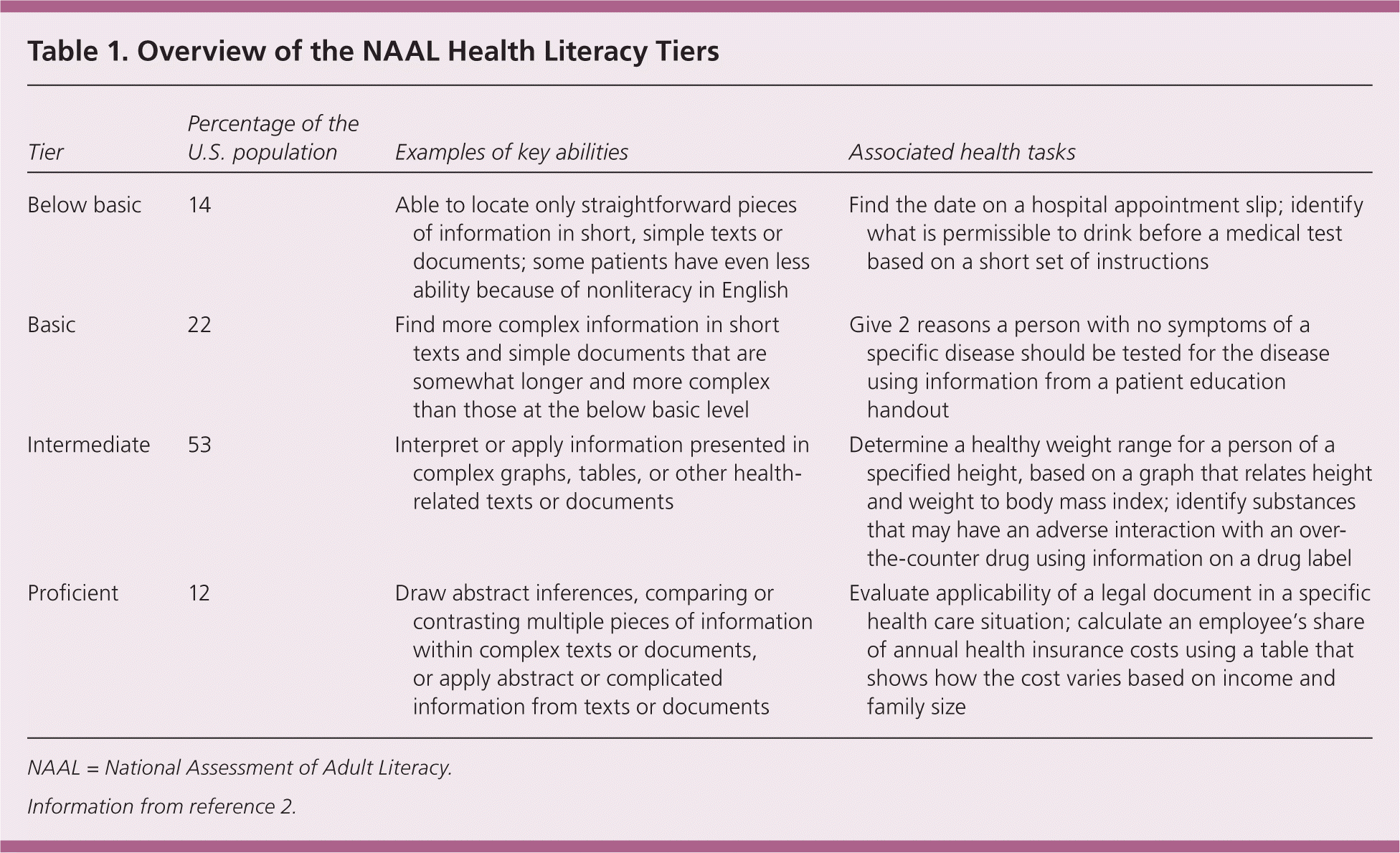
| Tier | Percentage of the U.S. population | Examples of key abilities | Associated health tasks |
|---|---|---|---|
| Below basic | 14 | Able to locate only straightforward pieces of information in short, simple texts or documents; some patients have even less ability because of nonliteracy in English | Find the date on a hospital appointment slip; identify what is permissible to drink before a medical test based on a short set of instructions |
| Basic | 22 | Find more complex information in short texts and simple documents that are somewhat longer and more complex than those at the below basic level | Give 2 reasons a person with no symptoms of a specific disease should be tested for the disease using information from a patient education handout |
| Intermediate | 53 | Interpret or apply information presented in complex graphs, tables, or other health-related texts or documents | Determine a healthy weight range for a person of a specified height, based on a graph that relates height and weight to body mass index; identify substances that may have an adverse interaction with an over- the-counter drug using information on a drug label |
| Proficient | 12 | Draw abstract inferences, comparing or contrasting multiple pieces of information within complex texts or documents, or apply abstract or complicated information from texts or documents | Evaluate applicability of a legal document in a specific health care situation; calculate an employee's share of annual health insurance costs using a table that shows how the cost varies based on income and family size |
Using the NAAL designations, 36% of the U.S. adult population has a basic or below basic health literacy and therefore may face serious challenges in understanding and acting on health information. Even patients categorized as having intermediate health literacy may have difficulty accomplishing tasks essential for managing their health (e.g., correctly determining from instructions on a prescription bottle what time to take the medication based on mealtimes).2
Limited health literacy is more common in Hispanic (66%), black (58%), and American Indian and Alaska Native (48%) populations, and among those 65 years and older (59%). Limited literacy rates are also higher among those with less education, those who did not speak English before starting school, and those living below the poverty level.2 The NAAL also identified approximately 11 million adults as nonliterate in English, of whom 4 million could not complete the NAAL because of language barriers.
It is also important to recognize that health literacy skills can vary within one individual and change over time. Performance on health literacy tasks may be influenced by emotional state, acute pain or illness, vision and hearing deficits, and cognitive impairment.9
Implications of Limited Health Literacy
Numerous studies with varying methodological strengths have shown that deficiencies in health literacy contribute to poor health outcomes (higher mortality rates and worse overall health status), health disparities, and increased costs.3,8,10 The implications of health literacy (Table 23,8,11–22 ) are amplified in an increasingly complex and fragmented health care system that places growing demands on patients for self-care, care coordination, and system navigation. Shorter hospital stays, polypharmacy, multiple health care providers, and the rising prevalence of chronic disease all contribute to the increasing role that patients have in managing their own care.10 With this increased responsibility, limited health literacy has been associated with decreased cancer screening and immunization rates, more emergency department use, and higher rates of medication errors.3,8,11–22
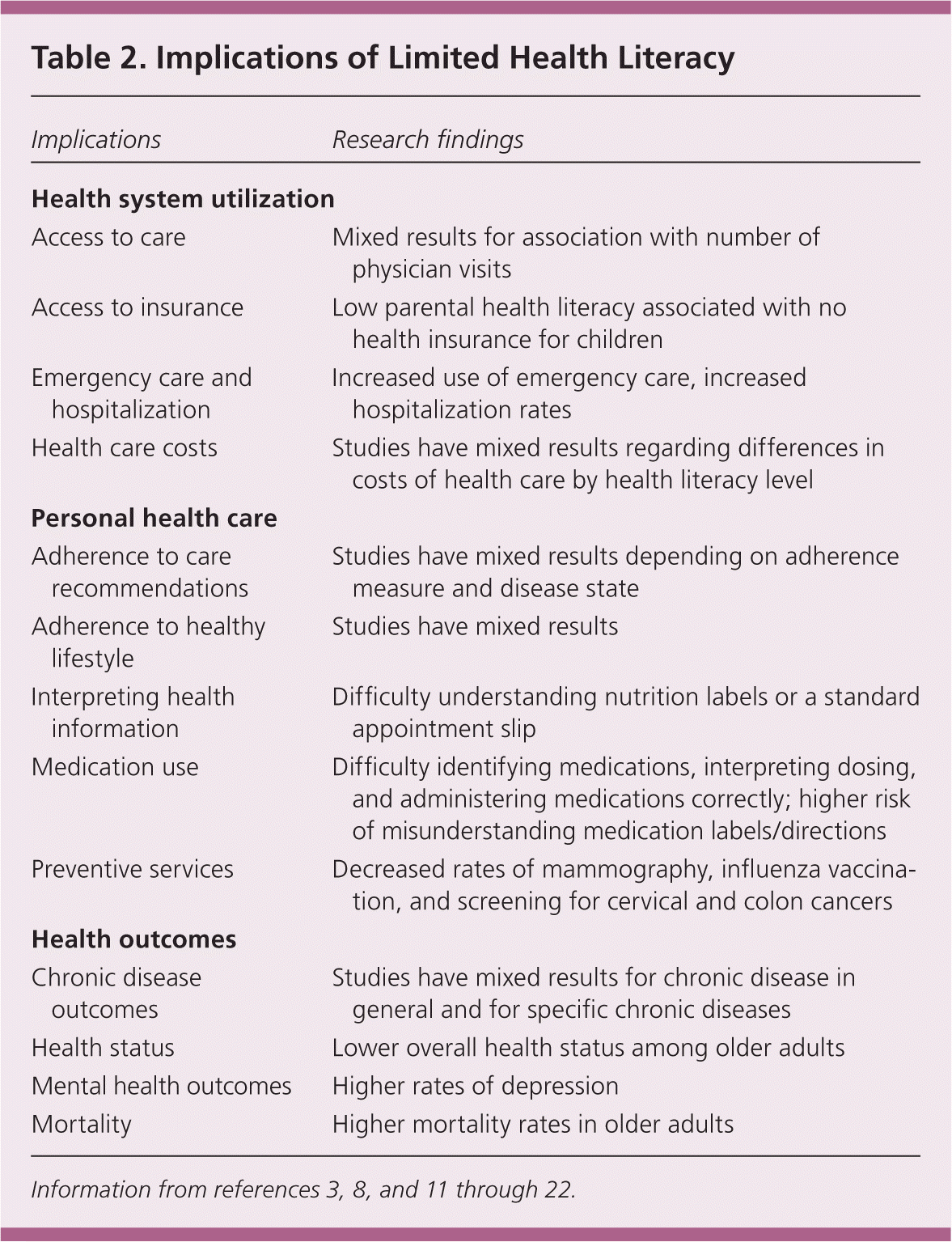
| Implications | Research findings |
|---|---|
| Health system utilization | |
| Access to care | Mixed results for association with number of physician visits |
| Access to insurance | Low parental health literacy associated with no health insurance for children |
| Emergency care and hospitalization | Increased use of emergency care, increased hospitalization rates |
| Health care costs | Studies have mixed results regarding differences in costs of health care by health literacy level |
| Personal health care | |
| Adherence to care recommendations | Studies have mixed results depending on adherence measure and disease state |
| Adherence to healthy lifestyle | Studies have mixed results |
| Interpreting health information | Difficulty understanding nutrition labels or a standard appointment slip |
| Medication use | Difficulty identifying medications, interpreting dosing, and administering medications correctly; higher risk of misunderstanding medication labels/directions |
| Preventive services | Decreased rates of mammography, influenza vaccination, and screening for cervical and colon cancers |
| Health outcomes | |
| Chronic disease outcomes | Studies have mixed results for chronic disease in general and for specific chronic diseases |
| Health status | Lower overall health status among older adults |
| Mental health outcomes | Higher rates of depression |
| Mortality | Higher mortality rates in older adults |
Assessment
Although there are several tools to assess health literacy (Table 3), they are mainly used in research.23–26 Studies have found that patients will accept health literacy screening if presented in an appropriate, sensitive fashion and that such screening does not engender feelings of shame or mistrust.27,28 However, because there is no evidence that assessing health literacy skills in practice settings improves outcomes, it is not recommended as part of routine clinical care.29

| Tool | Measurement | Administration time (minutes) | Number of items |
|---|---|---|---|
| Newest Vital Sign | Reading and applying information | 2 to 6 | 6 questions based on information from a nutritional label |
| Rapid Estimate of Adult Literacy in Medicine | Word recognition and pronunciation; provides an approximate grade level for reading ability | 3 | 66 medical terms to be read out loud |
| Short Test of Functional Health Literacy in Adults | Reading comprehension and numeracy skills | 7 to 12 | 2 prose passages and 4 items assessing numerical ability |
| Single Item Literacy Screener | Identification of patients who need help with reading health-related information | 1 to 2 | 1 question: How often do you need to have someone help you when you read instructions, pamphlets, or other written material from your doctor or pharmacy? |
| Test of Functional Health Literacy in Adults | Reading comprehension and numeracy skills | 22 | 3 prose passages followed by a 50-item reading comprehension section |
Interventions
Research on health literacy interventions has shown inconsistent results about the extent to which they improve long-term health outcomes.3,8,19 However, systematic reviews of interventions designed to improve different aspects of health literacy show an overall benefit of clear health communication strategies to optimize patient care.3,8,18 These strategies entail improving verbal and written approaches, along with increased sensitivity to how numerical data are presented (Table 4).3,8,10,16,30–33
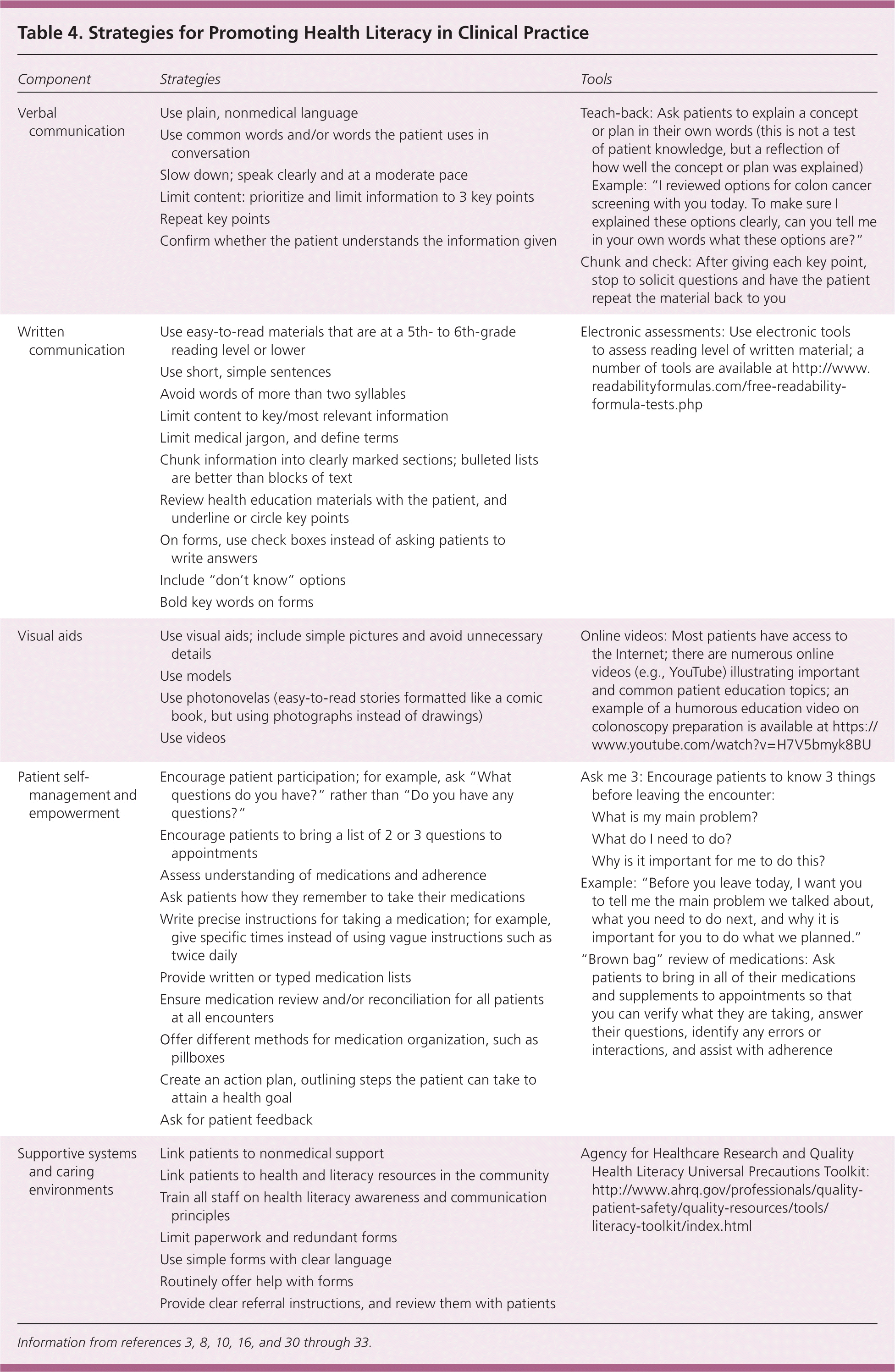
| Component | Strategies | Tools | |
|---|---|---|---|
|
|
| |
|
|
| |
|
|
| |
|
|
| |
|
|
| |
Organizations such as the American Medical Association and the Agency for Healthcare Research and Quality endorse adopting universal health literacy precautions (i.e., using easy-to-understand concepts and terms with all patients instead of focusing only on those with low literacy) to minimize the risk that an individual patient will not understand the information they are given.10,30,31
Recommendations for Enhancing Communication with Patients
VERBAL COMMUNICATION
Clinician-patient communication is a key component of patient care. Patients understand and retain about one-half of what is discussed in clinical encounters, and many do not feel comfortable asking for clarification or reiteration.34,35 With this in mind, the following strategies can be employed to promote clear and effective communication.
Avoid Making Assumptions About Language Preferences or Literacy Level. A patient's preferred language should be ascertained from the patient. If a clinician is unable to communicate effectively in the patient's preferred language, a trained interpreter should be used rather than relying on family members or untrained bilingual staff. Because literacy level cannot be determined by appearances, clinicians should never assume a patient's level of understanding.10,30
Use Plain, Nonmedical Language. Clinicians often use medical jargon that patients do not understand, particularly during critical moments of patient education or while developing a treatment plan.36,37 Clinicians should speak slowly and clearly, and strive to mirror a patient's vocabulary.33,38 Even patients with high literacy skills may have minimal understanding of medical terms. If a medical term is used, it should be clearly explained. Table 5 lists resources for improving communication in health care settings.
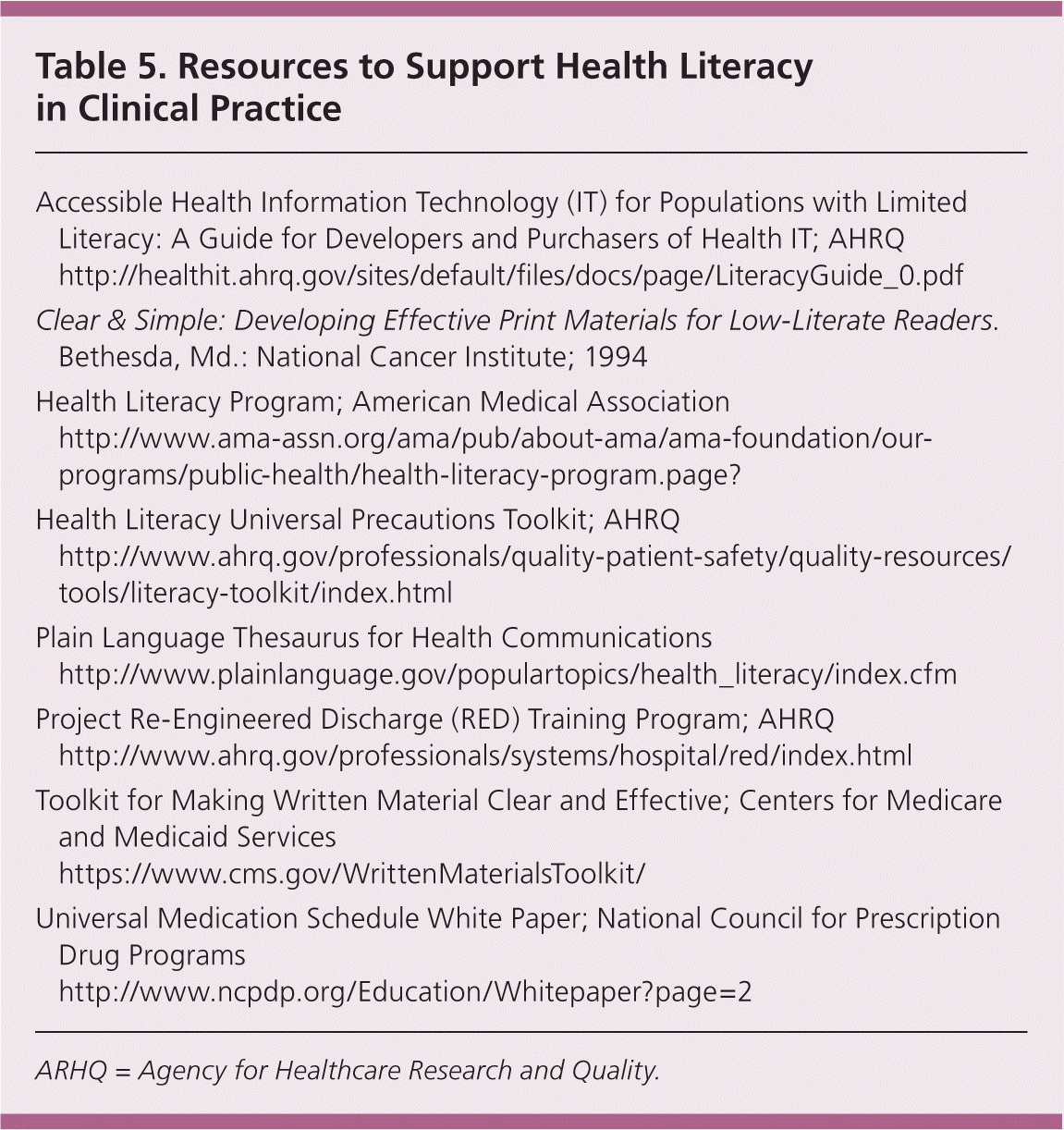
| Accessible Health Information Technology (IT) for Populations with Limited Literacy: A Guide for Developers and Purchasers of Health IT; AHRQ | |
| http://healthit.ahrq.gov/sites/default/files/docs/page/LiteracyGuide_0.pdf | |
| Clear & Simple: Developing Effective Print Materials for Low-Literate Readers. Bethesda, Md.: National Cancer Institute; 1994 | |
| Health Literacy Program; American Medical Association | |
| http://www.ama-assn.org/ama/pub/about-ama/ama-foundation/our-programs/public-health/health-literacy-program.page? | |
| Health Literacy Universal Precautions Toolkit; AHRQ | |
| http://www.ahrq.gov/professionals/quality-patient-safety/quality-resources/tools/literacy-toolkit/index.html | |
| Plain Language Thesaurus for Health Communications | |
| http://www.plainlanguage.gov/populartopics/health_literacy/index.cfm | |
| Project Re-Engineered Discharge (RED) Training Program; AHRQ | |
| http://www.ahrq.gov/professionals/systems/hospital/red/index.html | |
| Toolkit for Making Written Material Clear and Effective; Centers for Medicare and Medicaid Services | |
| https://www.cms.gov/WrittenMaterialsToolkit/ | |
| Universal Medication Schedule White Paper; National Council for Prescription Drug Programs | |
| http://www.ncpdp.org/Education/Whitepaper?page=2 | |
Speak Slowly and Break Down Information into Small, Manageable Steps. Complex instructions are more challenging to understand, remember, and follow. Information or instructions should be simplified into individual steps or units and should be concrete and specific.10,16,30 For example, instead of telling a patient to eat a healthier diet, a physician can offer specific suggestions, such as telling the patient to eat five servings of vegetables a day and teaching about the plate-size method.39 Limiting the focus of each clinical encounter to about three key messages increases comprehension of both low- and high-literacy patients.30,36,37
Confirm Patient Understanding. Patients rarely disclose whether they comprehend the information presented to them. One way to assure that patients have clearly understood the information is to use the teach-back method. This entails the patients explaining the new information in their own words, allowing the clinician to assess for comprehension. The teach-back method should be framed to assess the effectiveness of the clinician's communication rather than to test the patient's learning skills. This method has been shown to increase glycemic control in patients with diabetes mellitus36 and improve comprehension of the informed consent process.40 Although the teach-back method may improve patient understanding, it has not been shown to affect 30-day rehospitalization rates.41
PRINTED COMMUNICATION
Written materials should be used to reinforce verbal communication. A Cochrane review demonstrated that verbal and written information increases patient satisfaction and knowledge compared with verbal information alone.42 Written materials should be at or below a fifth- to sixth-grade reading level. Easy-to-use tools to evaluate the reading level of written materials are available at http://www.readabilityformulas.com/free-readability-formula-tests.php.
Numerical Data
Quantitative or numerical data have a prominent role in health care discussions and decisions. These data include statistics about the benefits and risks of preventive behaviors, medications, and procedures, as well as disease risk and prognosis. Many physicians presume that the use of numbers will empower patients to make informed decisions and adopt healthier behaviors. However, many Americans have low numeracy skills, or have difficulty understanding or processing numbers.46 A study of patients in an asthma clinic found that two-thirds of all patients (not just those with limited health literacy) did not understand what 1% meant.47 Furthermore, the way in which numerical data are presented influences how patients understand and act on information.48 Although the most effective ways to communicate numerical data are unclear, several suggested approaches to improving patients' comprehension of health-related numbers are reviewed in Table 6.3,8,10,16,30,46,49,50
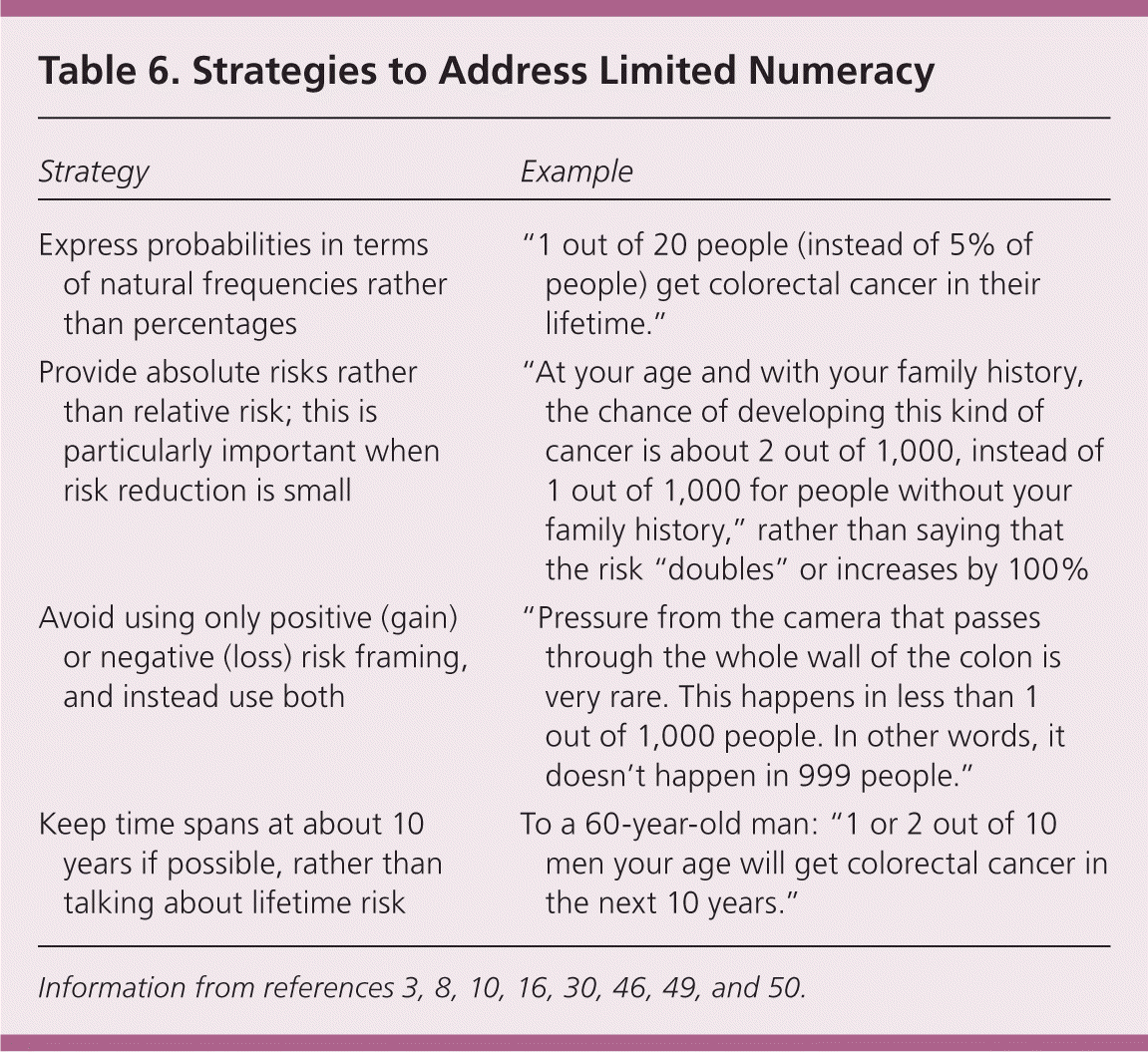
| Strategy | Example |
|---|---|
| Express probabilities in terms of natural frequencies rather than percentages | “1 out of 20 people (instead of 5% of people) get colorectal cancer in their lifetime.” |
| Provide absolute risks rather than relative risk; this is particularly important when risk reduction is small | “At your age and with your family history, the chance of developing this kind of cancer is about 2 out of 1,000, instead of 1 out of 1,000 for people without your family history,” rather than saying that the risk “doubles” or increases by 100% |
| Avoid using only positive (gain) or negative (loss) risk framing, and instead use both | “Pressure from the camera that passes through the whole wall of the colon is very rare. This happens in less than 1 out of 1,000 people. In other words, it doesn't happen in 999 people.” |
| Keep time spans at about 10 years if possible, rather than talking about lifetime risk | To a 60-year-old man: “1 or 2 out of 10 men your age will get colorectal cancer in the next 10 years.” |
Data Sources: A PubMed search was completed in Clinical Queries using the key terms health literacy, numeracy, interventions, and assessment. The search included meta-analyses, randomized controlled trials, clinical trials, and reviews. We limited our search to articles written in English. We also searched the Agency for Healthcare Research and Quality Evidence Reports, National Guideline Clearinghouse, Medline, and Google Scholar. There were no specific date parameters. Search date: November 11, 2014.
